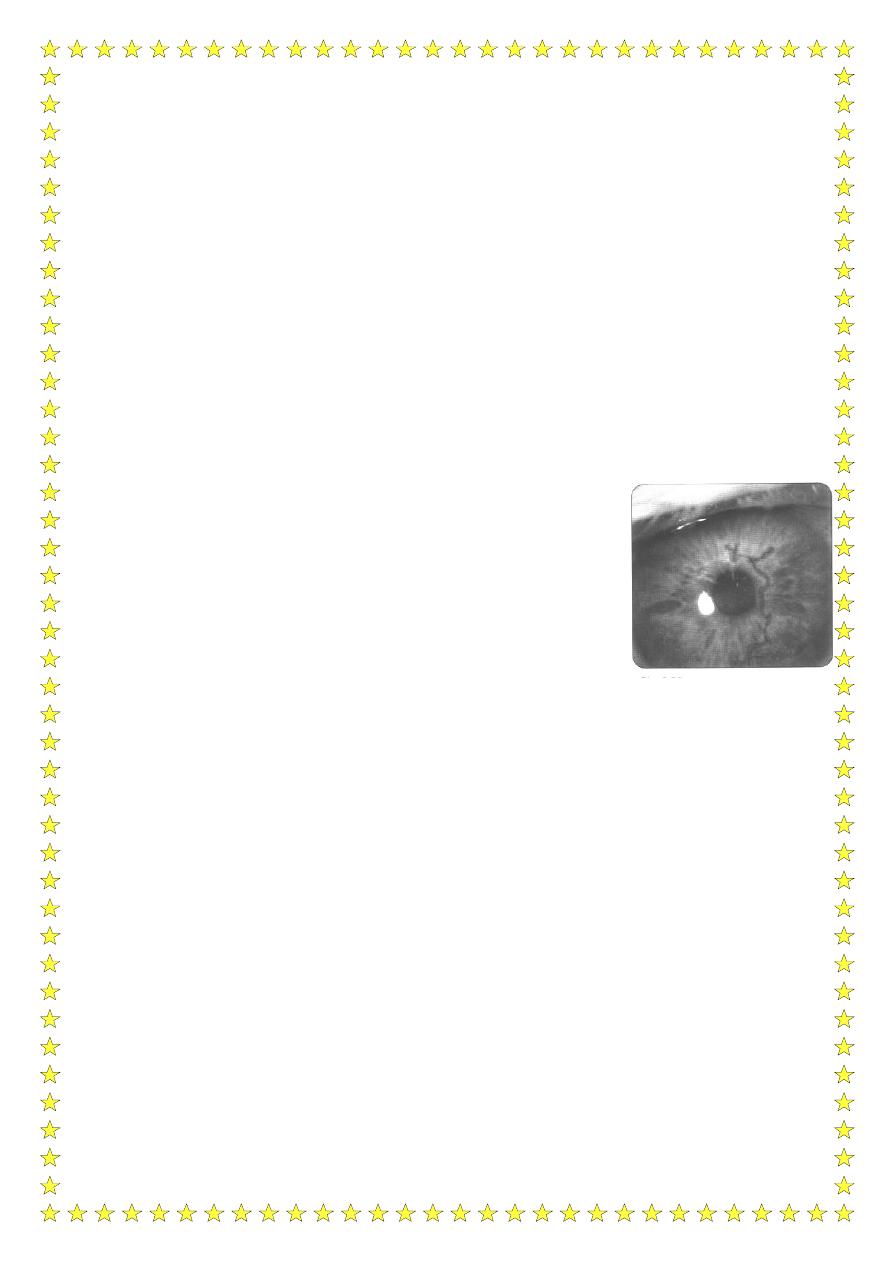
The cornea
Gross Anatomy:
The cornea is the anterior continuation of the sclera; it forms 1/6
th
of the outer layer of eyeball. It is a transparent structure; its function
is facilitating entrance and focusing the light rays on the retina. It
represents the most important refractive organ in the eye.
Applied anatomy:
The cornea consists of the six following layers: (from anterior to
posterior or from external to internal)
1- The epithelium: is stratified (multiple cell layers), squamous and
non-keratinized. If, there is any damage, it regenerates without any
scarring.
This layer is composed of basement membrane posteriorly and
attaching to it a layer of columnar cells by hemidesmosomes, then 2-
3 layers of wing cells and at anterior-most, there are 2 layers of
squamous cells.
2- Bowman's layer:
This is acellular superficial layer of the stroma which scars when
damaged.
3- The Stroma: makes up 90% of the corneal
thickness. It is composed of regularly oriented
layers of collagen fibrils whose spacing is
maintained by glycosaminoglycan (GAG) ground
substance, the distance between the fibrils is
slightly less than half of the wave length of incident
light, so the reflected rays from the cornea will one
cancel the other by the process of destructive
interference and the cornea appears transparent as
long as the lattice arrangement was maintained (Maurice theory).
4- Dua’s Layer: new layer discovered recently by Harminder Singh
Dua’s, university of Nottingham in 2013 during corneal graft
surgery. It is 15 micrometers in thickness, fourth caudal layer, and
located between the corneal Stroma and Descemet's membrane.
Anatomically, it is like Stroma and can be separated with the
Descemet's membrane from the anterior part of stroma if air is
injected within stromal layer. Rapture of this layer lead to passage of

aqueous from AC into Stroma in a condition called acute hydrops of
patients with keratoconus.
5- Descemet's membrane: it is composed of a fine latticework of
collagen fibrils. It is the basement membrane of the endothelial cells.
6- The endothelium:
It consists of a single layer of hexagonal cells. It plays a vital role in
maintaining corneal transparency & deturgescence, as water
composes 70% of cornea that makes it relatively dehydrated as
compared with other body tissues where water might composes even
98% of them. It has an active pump mechanism that removes the
fluid from Stroma. Normal cell count is 2500-3000 cell/ mm
2
. With
advancing age, the number of endothelial cells decreases and they
are non-regenerative cells, therefore the neighboring cells enlarge to
fill the gaping space.
The cornea is transparent for the following reasons:
1- The epithelium is not keratinized.
2- The stroma is regularly oriented. (Maurice theory)
3- The endothelium has active pump, it pushes the fluid into aqueous
and it acts as barrier to prevent entrance of aqueous inside the
cornea.
4- The corneal nerves are unmylinated.
5- It contains NO blood vessels.
6- It contains NO pigments (as melanin).
Signs of corneal diseases:
1- Epithelial signs:
a- Punctate epithelial erosions (PEE):
Are tiny, slightly depressed, epithelial defects (micro-ulcers seen
by slit-lamp), which stain with fluorescein.
* Fluorescein is vital extracellular stain. It stains living tissue e.g.
the base of ulcer, while Rose-Bengal is non-vital intracellular stain.
It stains dead cells at the margin of ulcer and mucus.
causes: vernal keratoconjunctivitis, poorly fitting contact lens, dry
eyes, decreases corneal sensation (as in trigeminal nerve palsy or
after herpes simplex viral keratitis), exposure to ultraviolet (e.g. in
wilding flash), corneal exposure and toxicity from drops (e.g.
Amino glycosides).

b- Punctate epithelial keratitis (PEK):
Is the hallmark of viral infections, it is characterized by granular,
opalescent, swollen epithelial cells stained with rose Bengal stain
but not fluorescein.
c- Epithelial edema:
It is a sign of endothelial decompensation or severe and sudden
elevation of intraocular pressure (as that occurring in acute
glaucoma as IOP is raised leading to edema that affects the vision).
d- Filaments:
Small, comma-shaped mucus strands lined with epithelium (one
end attached to the epithelial cornea and the other is free), which
stain well with Rose-Bengal stains.
Causes:
Keratoconjunctivitis sicca (dry eye), recurrent erosion syndrome,
prolong eye patching, corneal exposure, diminished corneal
sensation and herpes zoster ophthalmicus.
e- Pannus:
It is inflammatory or degenerative sub-epithelial ingrowths of
fibrovascular tissue from limbus.
2- Stromal signs:
a- Stromal infiltration:
Focal areas of active stromal inflammation composed of
accumulations leucocytes and cellular debris. These focal areas are
granular, gray-white opacities within the stroma.
Causes:
i- Non-infectious (Antigen sensitivity): e.g. contact lens wear and
marginal keratitis.
ii- Infectious keratitis: e.g. bacteria, viruses, fungi and protozoa.
b- Stromal oedema:
Causing disturbance of regularly arranged collagen fibers (or
fibrils) that affects eye vision by disturbance of corneal
transparency (according to Maurice theory), so it affects optically
empty spaces between stromal lamellae associated with increase
corneal thickness and decreased its transparency.

Causes:
Keratoconus, Fuch's dystrophy (Hereditary abnormal endothelium
or decreased number of endothelium cells) and surgical damage to
the corneal endothelium (iatrogenic).
c- Vascularization:
Causes: Wide variety of corneal disorders, e.g. microbial keratitis,
chemical
burns,
trauma,
TB,
syphilis
and
autoimmune
Keratoconjunctivitis (Cicatricial Pemphigoid and Stevens Johnson
syndrome).
3- Descemet's membrane signs:
a- Breaks in the Descemet's membrane:
Causes: Corneal enlargement e.g. congenital glaucoma, birth
trauma and keratoconus. It leads to influx of aqueous causing
stromal oedema.
b- Folds in the Descemet's membrane (Striate keratopathy):
Causes: Surgical trauma, ocular hypotony, stromal inflammation
and oedema.
* Normal IOP is 10-21 mm Hg, if it is less than 6 mm Hg then it is
hypotony.
Microbial keratitis
1- Bacterial Keratitis:
Predisposing factors:
- Bacteria capable of penetrating intact epithelium include Neisseria
gonorrhoea and H. influenzae.
- Other bacteria are capable of producing keratitis only after
compromisation of epithelial integrity with the following factors:
a- Contact lens wear: is the most common predisposing factor in
patients with previously normal eye therefore meticulous lens
hygiene is vital.
b- Pre-existing corneal disease: such as trauma (usually after
surgery of cataracts), bullous keratopathy (if there is endothelial
decompensation it leads to oedema that may persist and leads to
formation of bullae of fluid in the stroma), exposure keratopathy
and diminished corneal sensation.
c- Other factors: chronic blepharoconjunctivitis, chronic
dacryocystitis,
dry
eyes,
topical
steroid
therapy
and
hypovitaminosis A.

Clinical Features:
Symptoms:
These are: foreign body sensation, photophobia, blurring of vision,
pain, eyelid oedema and discharge.
Signs:
- Conjunctival and circumcorneal injection (almost always some
sort of anterior uveitis is associated with Keratitis).
- Epithelial defects associated with an infiltrate around the margin
and base.
- Enlargement of the infiltrate associated with stromal oedema.
- Secondary sterile anterior uveitis with hypopyon.
- Progressive ulceration may lead to corneal perforation and
bacterial endophthalmitis (involvement of all intraocular tissues).
Differential diagnosis of bacterial keratitis:
a- Fungal keratitis.
b- Acanthamoeba keratitis.
c- Stromal necrotic herpes simplex keratitis.
d- Marginal keratitis.
e- Sterile inflammatory corneal infiltrates associated with contact
lens wear.
Treatment:
a- Topical antibiotics:
- Initial instillation of fortified antibiotic is at hourly intervals.
- If response is favourable, frequency is decreased to 2-hourly
during waking hours.
- Then fortified drops can be replaced by weaker commercial
preparations, which are then tapered and eventually discontinued.
b- Oral ciprofloxacin (750mg twice daily):
- Copious secreted in the tears.
- Lipid soluble and has excellent intraocular penetration.
c- Atropine: it prevents the formation of posterior synechiae
(adhesions between papillary margin and lens).
- Reduce pain from ciliary spasm and associated uveitis.
d- Steroid therapy: It is controversial, the potential benefits of
topical steroids in reducing stromal necrosis and scaring should be

weighed against decreased fibroblast activity and increased risk of
perforation.
We can use it only when cultures become sterile and there is clear
evidence of improvement (7-10 days after initial treatment).
2- Fungal keratitis:
Rare infection but have devastating effects, the most common
pathogens are:
- Filamentous fungi (Asperigillus and Fusarium species): Infection
occurs after trauma by wood usually.
- Candida albicans: Usually infects immuno-compromised patients.
Clinical features:
Symptoms:
- Gradual onset of foreign body sensation, Photophobia, Blurred
vision (due to opacification of cornea, whether due to epithelial or
stromal edema) and discharge (mucopurulent).
* Progression is much slower and less painful than in bacterial
keratitis.
Signs:
Filamentous keratitis:
- A grayish, stromal infiltration with indistinct margin.
- Surrounding, satellite, feathery, finger-like lesions (extensions).
- Hypopyon (pus in the anterior chamber).
* There is always some sort of iritis associating keratitis.
Candida keratitis:
- A yellow-white, stromal infiltration associated with dense
suppuration similar to bacterial keratitis.
Treatment:
a- Topical treatment:
Filamentous: Natamycin 5%, and may add Amphotericin 0.15%.
Candida: Imidazole 1% or Flucytosine 1%.
b- Systemic antimycotics: e.g. Ketoconazole (tablets) or
Itraconazole in severe keratitis or endophthalmitis.
c- Therapeutic penetrating keratopathy: In unresponsive cases (if
there is resistant infection).
3- Viral keratitis:
A- Herpes simplex keratitis:
}
for 6
weeks

Basic concepts:
- HSV is a DNA virus, which infects only human.
- Infection with HSV is common, up to 90% of the population is
sero-positive for HSV-1 antibodies although most infections are
sub-clinical.
- HSV-1 predominantly causes infection above the waist (face, lips
and eyes).
- HSV-2 typically causes venereally acquired infection below the
waist (genital herpes).
- Rarely HSV-2 may be transmitted to the eye through infected
genital secretions, either venereal or at birth.
i- Primary infection:
It is usually occur in early childhood through droplet (the most
common route) or direct inoculation. It may be sub-clinical or may
cause mild fever, malaise and URT infection. In immuno-
compromised subject, the infection may become generalized and
life threatening.
ii- Recurrent disease:
- Following primary infection, the virus travels up to the ganglion
(trigeminal "Gasserian" for HSV-1 and spinal for HSV-2), where
it lies in a latent state.
- This latent state may subsequently reverse and the virus re-
activates, replicates & travels down to its target tissue causing
recurrent disease (genital herpes, herpes labialis & herpes
keratitis).
Primary ocular infection:
- Typically occurs in children between ages of 6 months- 5 years,
and may be associated with generalized symptoms.
Signs:
- Skin vesicles typically involve the lids and periorbital area.
- Acute, unilateral, follicular conjunctivitis associated with tender
lymphadenopathy.
- Secondary canalicular obstruction may occur (the infection by
itself causes lacrimation, but if it is complicated by secondary
canalicular obstruction this will cause epiphora).
- Keratitis is uncommon.

Treatment:
- Aciclovir (Zovirax
®
) eye ointment five times a day for three
weeks to prevent keratitis.
Recurrent herpes simplex ocular disease (Epithelial keratitis):
Presentation:
- Occurs at any age.
- Mild discomfort.
- Watering eye.
- Blurring of vision.
Signs: (in chronological)
- Opaque epithelial cells or punctuate epithelial keratitis.
- Central desquamation results in a linear-
branching (dendritic) ulcer.
- Decreased corneal sensation (as it involves the
nerves).
- Anterior stromal infiltration under the ulcer.
- Progressive centrifugal (from the center
outwards) enlargement may result in a large
epithelial defect with a geographical or amoeboid
configuration, especially in the context of injudicious topical
steroid therapy.
- Following healing, there are persistent linear-branching shapes,
which represent waves of healing epithelial cells.
Differential diagnosis of dendritic ulceration: (pseudo-dendritic
ulceration)
a- Herpes Zoster keratitis.
b- Healing corneal abrasion.
c- Soft contact lens wear.
d- Acanthamoeba keratitis.
e- Toxic keratopathies (kertitis medicamentosa).
Treatment of Herpes simplex epithelial keratitis:
a- Topical: without treatment, 50% resolves spontaneously, with
treatment, the cure rate is 95%.

i- Aciclovir 3% ointment, five times daily for 2 weeks.
ii- Ganciclovir 0.15% (Virgan
®
) gel: it is a new preparation which is
used five times daily and is as effective as Aciclovir.
iii- Trifluorothymidine 1% drops: it is used every 2 hours during the
day for 2 weeks , like Aciclovir, it has a cure rate of 95%, but it is
more toxic.
b- Debridement: Which is used in dendritic but not geographic
ulcers in patients who are: non-compliant, allergic to drugs, when
antiviral agents are not available and resistant cases. Drugs are ideally
used after debridement. Cure rate is above 50% and below 95%.
B- Herpes Zoster ophthalmicus (HZO):
It is a disease caused by Varicella Zoster virus (VZV), which is
morphologically identical to HSV but different antigenically and
clinically.
Chickenpox (Varicella) and Zoster are different conditions caused by
the same virus, Zoster mainly affects elderly patients. Primary disease
occurs during childhood is usually chickenpox after an attack of
chickenpox, virus remains dormant in sensory root ganglia. Later, it
reactivates and migrates back down sensory nerves to the skin and eye
causes the characteristic lesions. Herpes zoster in a young person
makes us to think about either immune compromised patient or one
with AIDS.
- Approximately, 15% of all cases of herpes zoster affect the
ophthalmic division of the trigeminal nerve (HZO).
* If we have crust lesion at the tip of the nose "Hutchinson sign", it
indicates ocular involvement (Because the distribution of the
ophthalmic division of the trigeminal nerve)
Ocular involvements occur by the following mechanisms:
i- Direct viral invasion, which results in epithelial keratitis and
conjunctivitis.
ii- Secondary inflammation.
iii- Occlusive vasculitis.
iv- Autoimmune: stromal keratitis, uveitis, scleritis and episcleritis,
all are not due to invasion of the virus directly.
v- Hypoaesthesia (due to denervation of the cornea) may result in
neurotrophic keratitis.

systemic features:
Influenza-like illness: Fever, malaise, headache and depression.
Herpetic neuralgia: Varies from a superficial itching or burning
sensation to severe deep boring or lancing pain.
Skin rash: Progress rapidly from papules
vesicles
pustules
crust and scar formation.
Ocular Features:
Keratitis, conjunctivitis, episcleritis, scleritis and anterior uveitis.
Neurological Complication:
Cranial nerve palsies: 3
rd
, 4
th
or 6
th
cranial nerve palsy.
Optic neuritis.
Encephalitis.
Contralateral hemiplegia.
Treatment:
Systemic: Valaciclovir 1g t.i.d for 7 days
Or Famciclovir 250mg t.i.d for 7 days.
Topical: a- Skin: Steroid + Antibiotics skin cream, e.g.
Hydrocortisone 1% with Fusidic acid 2%.
b- Eye: Herpetic ulcer Aciclovir ointment.
Autoimmune Topical steroid. Sometimes, both of them are used.
* Unlike herpes simplex keratitis, here we can use steroids from the
beginning of the treatment accompanying other medications, as the
mechanisms of inflammation are different (points 2 to 5 in
mechanisms of ocular involvements).
Keratoconus
It is a progressive disorder in which the cornea assumes an
irregular conical shape. The onset is at around puberty with slow
progression thereafter and become stationary at any time (age).
In keratoconus, there is progressive and irregular changes in the
cornea making it more convex and make it have a more conical shape,
also there is severe thinning of the cornea that the cornea may reach
1/3 its original thickness (about 0.16mm). These deformities will

affect the visual acuity (as the cornea is the most important focusing
power) leading to myopia and irregular astigmatism.
Presentation:
1- Unilateral impairment of vision due to progressive myopia and
regular astigmatism, which subsequently becomes irregular.
2- Frequent changes in spectacle prescription or decrease tolerance to
contact lens (due changes in the shape of cornea).
3- The fellow eye usually has normal vision with negligible
astigmatism at presentation because of the asymmetrical nature of
the condition. Most [not all] of the cases are bilateral.
Signs of keratoconus:
The hallmarks are: 1- Central or paracentral stromal thinning.
2- Apical protrusion.
3- Irregular astigmatism.
1- Direct ophthalmoscope from a distance of one foot shows an oil
droplet reflex.
2- Retinoscpoy (used for diagnosis of refraction errors) shows an
irregular reflex.
3- Slit-lamp shows very fine, vertical, deep stromal striae "Vogt's
lines" due to protrusion of cornea.
4-
Epithelial iron deposits, best seen with a cobalt blue filter, may
surround the base of the cone (Fleischer ring).
the base of the
5- Later, there is progressive corneal thinning as little as one third of
normal thickness, associated with poor visual acuity (irregular
myopic astigmatism).
6- Bulging of the lower lid in down gaze "Munson sign".
7- Acute hydrops: It is an acute influx of aqueous into the cornea as
a result of a rupture in Descemet's membrane and Dua’s layer
sudden decrease in visual acuity associated with discomfort and
watering (lacrimation).
The break usually heals within 6-10 weeks and the corneal oedema
clears, but a variable amount of stromal scarring may develop.
Management:
1- Spectacles: In early cases to correct regular and mild irregular
astigmatism.

2- Rigid contact lenses: For higher degree of irregular astigmatism,
they only reshape the cornea, there refractive power is zero.
3- Keratoplasty: In advanced progressive disease, especially with
significant corneal scarring.
4- intracorneal ring segment (Intacs) implantation: which is done
by using laser or mechanical channel creation. These rings which are
inserted inside these corneal channels can change the abnormality in
the curvature of cornea and causing moderate visual improvement.
5- corneal collagen cross-linking: is done by using riboflavin
(vitamin B2) drops to photosensitizer the eye followed by exposure
to ultraviolet-A light. This a newer treatment which offers promise of
stabilization or reversal of ectasia in at least some patients. It can
combined with Intacts insertion.
Note: lasik is contraindicated in correction of myopia and
astigmatism induced by keratoconus because it lead to more thinning
and ectasia of the cornea and sever deterioration of vision later on.
Keratoplasty (Corneal transplantation, Grafting)
It is an operation in which abnormal corneal host tissue is replaces
by healthy donor cornea, it is either Full-thickness (Penetrating
Keratoplasty) or Partial thickness (Lamellar Keratoplasty and
endothelial Keratoplasty).
1-Penetrating keratoplasty: Indications:
a- Optical keratoplasty: To improve visual acuity indicated in e.g.
keratoconus, dystrophies, degenerations, scarring of cornea and
pseudophakic bullous keratopathy (oedema due damage of the
endothelium after implantation of intraocular lens).
* The most common indication in western countries is pseudophakic
bullous keratopathy.
b- Tectonic keratoplasty: To restore corneal integrity, indicated in
stromal thinning and descemetoceles (A descemetocele is an
outward displacement, or ectasia, of Descemet's membrane in an area
where the overlying corneal stroma has been destroyed by
inflammation).

c- Therapeutic keratoplasty: Removal of infected corneal tissue in
eye unresponsive to antimicrobial therapy.
d- Cosmetic keratoplasty: Rare indication, to improve the
appearance of the eye.
2- Lamellar keratoplasty:
It involves partial-thickness excision of the corneal epithelium and
stroma so that the endothelium and part of the deep stroma are left
behind.
Indications:
a- Opacification of the superficial one-third of the corneal stroma.
b- Marginal corneal thinning or infiltration as in recurrent pterygium.
c- Local thinning or Descemetocele formation.
d- keratoconus because the endothelium is normal in this condition.
3- Endothelial Keratoplasty:
It involves partial thickness excision of the corneal endothelium,
Descemet's membrane and very thin part of stroma (Dua’s layer). It
is indicated when there endothelial damage e.g. pseudophakic bullus
keratopathy and Fuchs endothelial dystrophy.
